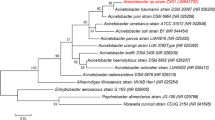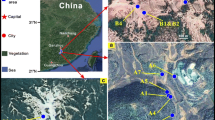Abstract
A bacterium that utilizes cyanide as a nitrogen source was isolated from soil after enrichment in a liquid medium containing potassium cyanide (10 mM) and glucose (1.0%, w/v). The strain could tolerate and grow in potassium cyanide at concentrations of up to 25 mM. It could also utilize potassium cyanate, potassium thiocyanate, linamarin and a range of aliphatic and aromatic nitriles. The isolate was tentatively identified as Burkholderia cepacia strain C-3. Ammonia and formic acid were found in the culture supernatant of the strain grown on fructose and potassium cyanide, no formamide was detected, suggesting a hydrolytic pathway for the degradation of cyanide. The cyanide-degrading activity was higher in early and the stationary phase cells. Crude cell extracts of strain C-3 grown on nutrient broth exhibited cyanide-degrading activity. The characteristics of strain C-3 suggest that it would be useful in the bioremediation of cyanide-containing waste.
Similar content being viewed by others
References
Cattaneo, M.V., Masson, C. & Greer, C.W. 1997 The influence of moisture on microbial transport, survival and 2,4-D biodegradation with genetically marked Burkholderia cepacia in saturated soil columns. Biodegradation 8, 87–96.
Di Cello, F., Bevivino, A., Chiarini, L., Fani, R., Paffetti, D., Tabbacchiono, S. & Dalmastri, C. 1997 Biodiversity of a Burkhoderia cepacia population isolated from the maize rhizosphere at different plant growth stages. Applied and Environmental Microbiology 63, 4485–4493.
Finnegan, I., Toerien, S., Abbot, L., Smit, F. & Raubenheimer, H.H. 1991 Identification and characterization of Acinetobacter sp. capable of assimilation of a range of cyano-metal complexes, free cyanide ions, and simple organic nitriles. Applied Microbiology and Biotechnology 36, 142–144.
Fisher, F.B. & Brown, J.S. 1952 Colorimetric determination of cyanide in stack gas and water. Analytical Chemistry 24, 1440–1444.
Harris, R. & Knowles, C.J. 1983 Isolation and growth of a Pseudomonas species that utilizes cyanide as a source of nitrogen. Journal of General Microbiology 129, 1005–1011.
Ingvorsen, K., Hoger-Pedersen, B. & Godtfredsen, S.E. 1991 Novel cyanide-hydrolyzing enzyme from Alcaligenes xylosoxidans sub sp. denitrificans. Applied and Environmental Microbiology 57, 1783–1789.
Johannsen, F.R., Levinskas, G.J. & Rodwell, D.E. 1986 Evaluation of the tetratogenic potential of three aliphatic nitriles in the rat. Fundamentals of Applied Toxicology 7, 33–40.
Kang, S.M. & Kim, D.J. 1993 Degradation of cyanide by a bacterial mixture composed of new types of cyanide degrading bacteria. Biotechnology Letters 15, 201–206.
Katayama-Fujimura, Y., Komatsu, Y., Kuraishi, H. & Kaneko, T. 1984 Estimation of DNA base composition by high performance liquid chromatography of its nuclease P1 hydrolysate. Agricultural and Biological Chemistry 48, 3169–3172.
Knowles, C.J. 1976 Microorganisms and cyanide. Bacteriological Reviews 40, 652–680.
Kolter, R., Siegele, D.A. & Tormo, A. 1993 The stationary phase of the bacterial life cycle. Annual Review of Microbiology 47, 856–874.
Kuntz, D.A., Chien-Sao, W. & Jiu-Lin, C. 1994 Alternative routes of enzymatic cyanide metabolism in Pseudomonas fluorescens NCIMB 11764. Microbiology 140, 1705–1712.
Marmur, J. 1961 A procedure for the isolation of deoxyribonucleic acid from microorganisms. Journal of Molecular Biology 3, 208–218.
Meyers, P.R., Gokool, P., Rawlings, D.E. & Woods, D.R. 1992 An efficient cyanide-degrading Bacillus pumilus strain. Journal of General Microbiology 137, 1397–1400.
Palleroni, N.J. 1984 Gram-negative aerobic rods and cocci, Family I Pseudomonadaceae. In Bergey's Manual of Systematic Bacteriology, Vol. I, eds Krieg N.R. & Holt J.G. pp. 144–199. London: Williams & Wilkins. ISBN 0-68304108-8.
Raybuck, S.A. 1992 Microbes and microbial enzymes for cyanide degradation. Biodegradation, 3, 3–18.
Seah, S.Y.K., Terracina, G., Bolins, J.T., Riebel, P., Snieckus, V. & Eltis, L.D. 1998 Purification and preliminary characterization of a serine hydrolase involved in the microbial degradation of polychlorinated biphenyls. Journal of Biological Chemistry 273, 22943–22949.
Simbert, R.M. & King, N.R. 1981 General characterization. In Manual of Methods for General Bacteriology, ed. Gerhardt, P. pp. 409–443. Washington, DC: American Society for Microbiology. ISBN 0-91482629-8.
Towill, L.E., Dury, J.S., Whitefield, B.L., Lewis, E.B., Galyan, E.L. & Hammons, S. 1978 Review of the Environmental Effect of Pollutants. V. Cyanide. US. Cincinnati, OH: Environmental Protection Agency. (EPA-600/1-78-027).
US EPA. 1984 Ambient Aquatic Life Water Quality Criteria for Cyanide-1984. US. Washington, DC: Environmental Protection Agency. (EPA-440/5-84-028).
Vaisanen, O.M., Weber, A., Bennasar, A., Rainey, F.A., Busse, H.-J. & Salkinoja-Salonen, M.S. 1998 Microbial communities of paper printing machines. Journal of Applied Microbiology 84, 1069–1084.
Yabuuchi, E., Kosako, Y., Oyaizu, H., Yano, I., Ohtta, H., Hashimoto, Y., Ezaki, T. & Arakawa, M. 1992 Proposal of Burkholderia gen. nov. and transfer of seven species of the genus Pseudomonas homology group II to the new genus, with type species Burkholderia cepacia com. nov. Microbiology and Immunology 36, 1251–1275.
Zaborina, O., Daubaras, D.L., Zago, A., Xun, L., Saido, K., Klem, T., Nikolic, D. & Chakrabarty, A.M. 1998 Novel pathway for conversion of chlorohydroxyquinol to maleylacetate in Burhholderia cepacia AC1100. Journal of Bacteriology 180, 4667–4675.
Author information
Authors and Affiliations
Rights and permissions
About this article
Cite this article
Adjei, M.D., Ohta, Y. Isolation and characterization of a cyanide-utilizing Burkholderia cepacia strain. World Journal of Microbiology and Biotechnology 15, 699–704 (1999). https://doi.org/10.1023/A:1008924032039
Issue Date:
DOI: https://doi.org/10.1023/A:1008924032039




